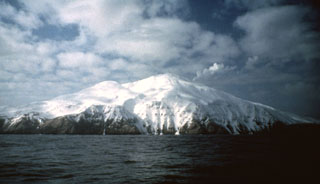Report on Kiska (United States) — May 1990
Bulletin of the Global Volcanism Network, vol. 15, no. 5 (May 1990)
Managing Editor: Lindsay McClelland.
Kiska (United States) Steam and ash plume
Please cite this report as:
Global Volcanism Program, 1990. Report on Kiska (United States) (McClelland, L., ed.). Bulletin of the Global Volcanism Network, 15:5. Smithsonian Institution. https://doi.org/10.5479/si.GVP.BGVN199005-311020
Kiska
United States
52.103°N, 177.602°E; summit elev. 1220 m
All times are local (unless otherwise noted)
A steam cloud emerging from an upper flank vent . . . was seen from neighboring Amchitka Island on 1 June at about 1000. Ash began mixing with the steam after ~30 minutes, and steam and ash emission remained visible until weather conditions obscured the volcano 3 hours later. At about 1500, a Reeve Aleutian Airways pilot reported a steam plume rising to ~3.5 km altitude, associated with a dispersed gray haze at about the same altitude. Authorities issued a NOTAM. When a U.S. Fish and Wildlife Service (FWS) vessel traveled past the N and W sides of Kiska Island on 3 June, no ash was visible on flank snow cover, although some light snow might have fallen since the eruption. Steaming from the W vent appeared typical. A plume from Kiska was clearly evident on radar aboard the Soviet vessel RV Vulkanolog, as it passed ~200 km N of Kiska on 4 June at 0800. However, no ashfall was noted at the ship.
Geological Summary. Conical Kiska volcano is the westernmost historically active volcano of the 2500-km-long Aleutian arc. The volcano lies at the northern tip of the elongated Kiska Island, across a low isthmus containing East Kiska and West Kiska lakes. A 400-m-wide elliptical crater, breached to the north, caps the 1220-m-high stratovolcano. The volcano is surrounded on three sides by sea cliffs up to 450 m high and overlies an older volcanic center exposed to the south. A massive submarine debris-avalanche deposit extends 40 km to the NNW. The southern part of the NE-SW-trending island, the westernmost of the Rat Island group, has been glaciated, but all lava flows post-date the last major glaciation. Young, steep-sided blocky lava flows, primarily on the N and SW flanks, have originated from vents at locations ranging from the summit to near sea level. A flank cinder cone and associated lava flows were erupted in 1962 at Sirius Point on the northern coast. The island contains one of the best harbors in the Aleutian Islands, but is uninhabited.
Information Contacts: AVO; Nikolai Seliverstov (chief of expedition, RVVulkanolog), IV; Eugene Yogodzinski (RVVulkanolog), Cornell Univ; Anchorage Times, AK.

